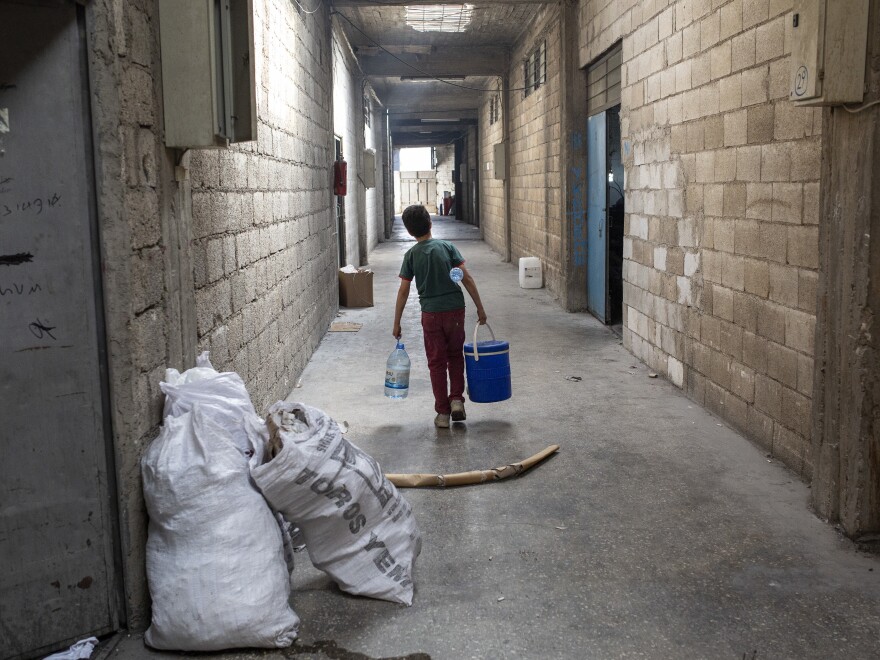The number of people currently enslaved in the world has grown by 10 million in the last five years, researchers from Geneva reported Monday.
The U.N.'s International Organization for Migration partnered with the International Labor Organization and the Walk Free Foundation, a human rights group, to produce the latest estimates of modern slavery.
That term refers to a spectrum of exploitative practices like forced labor, forced marriage and human trafficking. As of 2021, 50 million people were estimated to endure such conditions. Some form of modern slavery exists in nearly every country in the world, the report found.
Although modern versions of enslavement appear slightly different from historical examples, the two are interconnected, authors of the report said.
"In a number of ways, slavery has adapted and changed and shape shifted, but exploitation is still occurring on an unprecedented scale," Grace Forrest, the founder of Walk Free Foundation, told NPR.
"There is no region of the world that is immune to modern slavery."
The global estimates were the result of surveying tens of thousands of survivors of modern slavery over 68 countries along with research.
Forced labor is the biggest component of modern slavery
Many of the people characterized as modern slaves endure conditions considered "forced labor" — employed but unable to quit because their employer withholds their earnings, they owe debt to their employer or, for migrants, their employer threatens deportation.
In 2021, 28 million people were estimated to be working under forced labor conditions — an eighth of whom were children. According to the report, the majority of cases were found in the private sector, while in about 14% of cases governments imposed work requirements as a form of punishment, among other reasons. The greatest prevalence of forced labor was in Arab countries, followed by Europe and Central Asia.
The report also estimated roughly 22 million people were living in forced marriages in 2021. The number of people involuntarily wedded grew by 6.6 million compared to 2016. Nearly two-thirds of all forced marriages were found to be in Asia and the Pacific, followed by Africa, the survey found.
One of the drivers of forced and child marriages is poverty — oftentimes financially desperate families see marriage as a means to secure a stable future for their children, according to the report.
But once married, women in forced relationships are at higher risk of sexual exploitation, violence and domestic servitude, the report concluded.
A majority of all forced labor cases are in wealthy countries, report found
Researchers suggest that forced labor is as much of an issue in rich countries as in poor ones.
One reason is because wealthier countries participate in and benefit from global supply chains — multinational business operations where forced labor tends to be harder to inspect, Forrest said. Those companies account for 80 percent of forced labor cases, she added.
Richer countries are also more likely to have the demand and resources to enable coercive labor practices, Angela Me, the chief researcher at the U.N.'s office on drugs and crime, told NPR.
"Take for example of a domestic worker," she said. "In richer countries, you have more people that can afford to have a person come from abroad to work in the domestic area."
Me said forced labor in domestic work remains elusive because many work in isolation. That's partly why estimates on forced labor are likely to be an undercount, Me added.
"It is important for people to understand the trafficking of human beings is not something that is only happening in remote areas or countries where there is war," she said. "It happens there too but it can also happen next door."
The pandemic exacerbated modern slavery
The pandemic compounded underlying drivers of forced labor: the economic crisis led more people into debt to an employer while the virus put workers under greater health risks, Forrest said.
At the same time, there was a more urgent demand for COVID protective gear like face masks and gloves, which led some companies to adopt coercive labor practices to rush manufacturing.
"When you have a crisis, the first thing to go is the rights of the people who are most vulnerable in parts of the world where there is the least visibility," Forrest said.
For these reasons, the pandemic stymied some of the progress made in the fight against modern slavery, the report concluded. Forrest added that solutions are "far and few between" but they do exist.
In June, for example, the U.S. passed legislation that will force companies to prove that goods from China's Xinjiang region are not made with forced labor.
"It's shocking that any one person lives in modern slavery in 2022," she said. "It's completely unacceptable because we have every tool in our toolkit to be able to tackle this."
Copyright 2022 NPR. To see more, visit https://www.npr.org.



